Ry and I went out to the Boomershoot site with a new version of the chalk dispenser (also known as Blastmaster 6000). An identical unit was tested in California a few days ago using Tannerite and it worked well without showing any signs of weakness. We were pretty confident that it would hold up better than version 1.0.
We used 200 grams of Boomerite in each test. By volume this one cup, which was the same amount used the designers in their first tests. They later increased the amount to a soda can full with still no structural failures. We put 500 grams of chalk dust on top of the Boomerite.
In this first pictures you can see the chalk dust on top of the Boomerite. The zip lock bag of Boomerite is just visible in the front hole.
Ry will probably have video to share in a day or three but in the picture below you can see the dispenser was moved a couple feet by the blast. The dispenser appeared to be undamaged.
The second test was essentially the same as the first. The only intentional difference was that the Boomerite wasn’t poked partially through the front and rear holes. This time the dispenser was moved several feet and there was some obvious damage:
I set it up for a third test and expected it would probably “cut loose” this time. The movement was about the same and the fractures widened. Notice the bottom of the containment area is starting to bulge and the middle “rib” is bulging out the back too.
In terms of a long lasting target this has some problems. But it survived three uses which is as much as it really needs for the Boomershoot main event. We should consider cutting the Boomershoot charge in half because I think the ejection of the chalk will be sufficient with a much smaller charge.
On the drive back to my home in Moscow we pondered why the difference between their tests and ours. We had pretty much decided that it was because of the chalk dust on top of the explosives because we just couldn’t imagine Boomerite being that much different than Tannerite. But I replayed the video from the California tests and they used chalk too. So the only other variable that I can think of are the temperature and the Boomerite. Our temperature was about 24 F with the first test done while the metal was probably significantly above that because it had been in the warm vehicle. By the time of the second and third tests the metal was probably close to ambient temperature. Could that temperature change made the metal brittle and weaker?

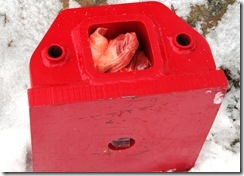

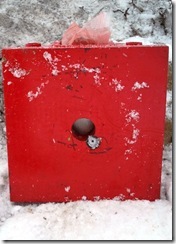
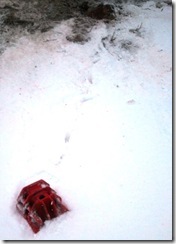


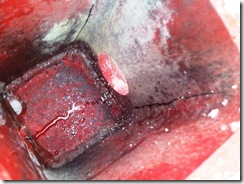
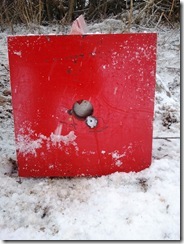
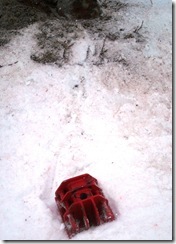
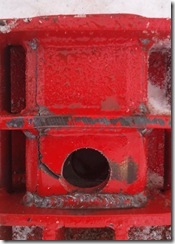
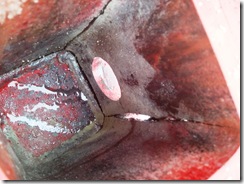
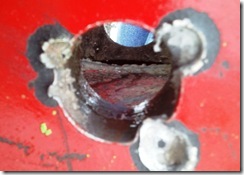
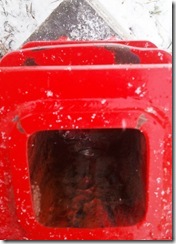
It can, but that usually is only significant at multiple tens of degrees below zero–say about 40-50 below. However, “usually” doesn’t apply to “holding explosives while they detonate”, so I don’t know. I have some buddies in shock physics I might be able to ask, but it would have to be a few weeks.
They should make the main container a cylinder. That way, the forces will be roughly uniform, rather than the corners being subject to both expansion and more significant deformation forces. They don’t make square cannons, after all. 🙂
-tspencer
I’m thinking 2 factors are involved. 1)The relative speed of the 2 different explosives. I suspect Tannerite is a bit slower allowing some of the explosive and the chalk to be pushed out of the container before all the explosive is consumed and lowering the actual pressure inside the container. Think Bullseye vs IMR-7828 in a short barrel. 2) Looking at your picture the chalk appears to be contained in a baggie, seems to be a fair amount of chalk. This could be “tamping” the charge and acting to contain the burn and increasing the pressure in the container, if only for a fraction of a second. Just like tamping down a charge in a black powder rifle or creating a shaped charge.
Perhaps reducing the charge a bit and putting the chalk in a container that doesn’t conform so closely to the sides of the dispenser, like maybe a paper bag, or a soda can with the top cut off. I used to do rock removal with ANFO and a cup in a small confined space can do a lot of damage. I also agree with tspencer that a round tube might hold up better by reducing the “stress risers” one gets with “square” corners.
Joe in Reno: it was 500 grams of chalk. Video on the link.
We used square tube so the 4″ boxes from the tree line targets could be dropped in to charge them on the first test target. We tested the second version here two weeks ago on a 72 degree day with tannerite. I did make a round tube version already, but the 2 1/2″ sq boxes for boomerite and chalk fit better in a square. I’m just looking for enough charge to shoot a cloud of colored chalk straight up so you know you hit it. We have since plated our test model with 1/4″ A500 to keep the bullets from doing so much damage at short range, even though we are building them for 650-700 yards.
What metal are they using for this? Steel? Iron?
It was mild steel.
Did the hits around the mouth cause detonation?
Chris,
I think the one at the 8:30 position did. But none of the others did.
I did not have a very steady position to shoot the gun from and I was breathing hard from walking up the hill so I had a few misses.
Ray: You do know that inside the 4″ box is a ziploc baggie full of boomerite that can conform to pretty much any shape, right? 🙂
Yes i do know there is a baggie inside the box. But I wanted to make it as simple as dropping in a standard target. We originally wanted to make one or two of these things for the 700 yard line and did not want it anyone to have to go to a lot of extra work to accomodate two or three shooters. Anyone will be welcome to shoot at them, and hitting a 1 1/2″ hole at 700 yards should get you a dust cloud that looks different than hitting a 7″ square. I can’t wait to see how many comments we get on “how easy they were to hit on the first shot” after the boomershoot…
Hey, I’d be happy to do the extra work if it would make your job easier! Or you could use 4″ diameter pipe. Whatever works! I’m just trying to help. 🙂
-tspencer
I think the additional “box’ structure behind the plate is simply not needed and is not easily workable to containing for any kind of repeated use of the structure – seems like a lot of work to go through for destruction after several uses. My suggestion would be to simply construct the plates with holes on a heavy duty stake frame system that could be placed in front of a regular Boomer target to shield it from all strikes but one through the center hole. A larger cardboard box could be used for the boomer with added chalk dust, if needed, in the top of the box – it should produce enough color to see the difference. However, I think you are over stating the need to have a big difference in color or some other attribute; Boomershoot is a “two man game” with a spotter and shooter. Trust me any good “Boomer team” is going to know damn well if they hit the boomer through the small opening. Hell, many of us routinely shoot at the Boomer targets when the get knocked off their sticks and are laying on their side on the ground providing a much smaller target profile – it is a good challenging target for spotter and shooter. With the simpler plate on frame design concept, you can easily produce more of the plates for the same cost in time and expense as the more complicated boxed in target holders. Just a suggestion.
cheers,
Bob
Just as a complete noob question, would perforating the structure holding the boomerite with lotsa holes allow detonation to proceed without damaging the structure, or would it just weaken the structure allowing quicker damage from multiple uses?
Mikee,
I suspect it is a close to a “zero sum game”.
Ry and I did other tests not mentioned here, hinted at in Ry’s video, and I’ll make another post with my video to explain them a little bit better. Basically those tests can be interpreted as saying what Bob P. (above) and Ry, I, and others have been saying would work will work.
What would stop the plate from bending in half like Ry’s railroad plate did and flying fifty yards down the hill knocking over half the regular boomer targets if you just placed the charge behind the it ? I watched Bills you tube video from our last year’s boomershoot, and some of the 4″ targets from the field fire do not even knock the wooden stakes over. How is it they split 1/2″ steel tube. I know I challenged it to be blown up, but all I want is a charge enough to spray chalk dust straight up into the air. We put a 1/2 pound jar of tannerite into our test and a cup of red chalk on top of it, and it made a cloud forty feet high that was very distinct. We tested it five times and it survived without even being staked down. We spot for each other too and know when we hit our targets and we are just trying to add a little more competition to the event for everyone. I could care less if these targets end up in the local scrap yard the day after the boomershoot, I wasn’t planning on hauling them back to California with me anyways. I made the clutch and brake pedal looking swinging targets that are on the tree line that almost survived two years just for everyone to shoot at. I enjoyed Ry’s rope hanging targets two years ago, i thought they were fun to shoot at and made it more interesting and I admire his creativity. I also thought riverdogs challenge last year was great even though I don’t have a hunting rifle, or i would have entered. I am sending my round tube test target now. Hopefully you won’t get tired of testing. I sure won’t get tired of building them and reading all the wonderful feedback . . i like building things…
Ray,
I have really enjoyed the give and take regarding the targets you are working on. I think a lot of what looks like criticism is really brainstorming trying to find a workable, durable solution. For instance…there is likely a significant difference in Tannerite and Boomerite when it comes to velocity. If I understand it correctly, Boomerite is a variation on the explosives that took down the Federal Building in Oklahoma City…in other words, a very high speed explosive in comparison to even Tannerite.
I have greatly appreciated your targets being on the hill the last couple years. Those 2 inch swingers were a lot of fun!!
Your targets were part of the inspiration for using the hanging colored balloons we used on Friday and Saturday last year, and we’ve spent months trying to figure out new ideas for the coming Boomershoot that also would make the clinic days more fun.
I really look forward to more testing, and I hope Joe keeps posting about the results.
As for not knocking over the stakes, but splitting steel? I think it all comes down to direction of force. Containment vessels have to be pretty doggone overbuilt in comparison.
Of course, Joe has probably forgotten more
Ooops…
Joe has forgotten more about explosives than I will ever know.
Don’t think i’m upset cause i’m not. The three of us that call ourselves the rumrunners ( pirate flag spots 65-68 ), bad mouth each other’s ability about shooting and building stuff every day. If this wasn’t fun, I would not be building them. I figured tannerite is less powerful than boomerite when I saw the damage. Our tannerite chalk displays look like the chalk display Joe got from version 1 and that is what we were looking for. We just got 40 more pounds of tannerite and plan on a few more tests of our own. I’m also bringing my new bowling ball mortar this year . . my next project will be that great square cannon idea that tspencer came up with. Watch for it at boomershoot 2012…
If Tannerite works, how about using Tannerite? Or reduce the Boomerite charge.
223 Bill just posted three of the displays we got from our tannerite tests on the chalk dispenser a couple weeks ago on you tube. the second one is a 1/2 pound jar of tannerite ( jar and all ) with 3/4 of a cup of chalk, launched from version 2. the third is the pepsi can full of tannerite and about a cup of chalk and it is a smaller display. they can be seen on you tube “testing on chalk dispenser”. we are only 150 yards away and it is kinda behind a tree but you can see the difference from an ordinary boomer.
i guess it is just called “Chalk Dispenser” …
I don’t know much about explosives but I do know a few things about metals. What if these boxes were made of solid titanium instead of steel? I know titanium is more expensive but it does have a higher melt point and it’s not as brittle as steel.